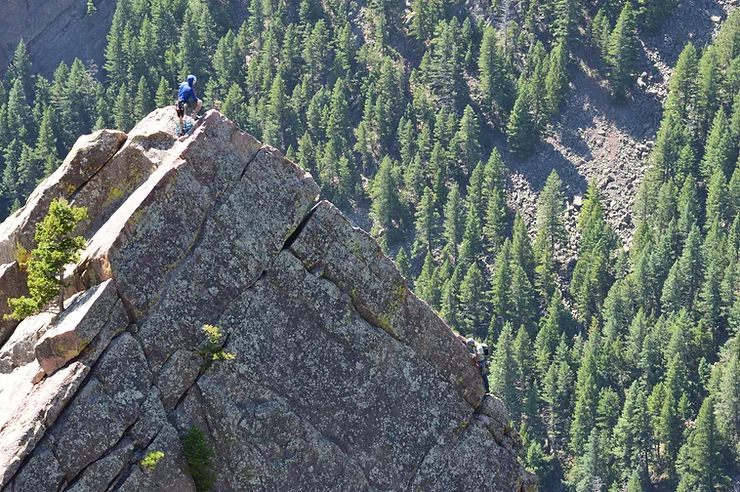
Howdy All!
This is Thomas checking in with you from Golden Mountain Guides. In this post I will explain what it takes to become an AMGA Rock guide along with sharing my personal journey in becoming a Certified Rock Guide. I will only explain the process to becoming a fully Certified Rock Guide; there are lower AMGA certifications available called Single Pitch Instructor and Multi Pitch Instructor that I will break down in another post. Rock Guide is the highest level AMGA Rock Certification.
Just another day in the office! Topping out the Yellow Spur, 5.9+ with a guest.
If you have been following along to our recent blogs, I think you will see a re-occurring theme. We strongly believe in the training and certification process of becoming an American Mountain Guides Association (AMGA) Guide. We are proud of our guides’ determination and commitment to following through the process of becoming a professional guide. I proudly display my AMGA Rock Guide patch on my beat up old climbing pack that has accompanied me to countless summits on 5 different continents. But what does it actually take to earn that patch? Keep reading to find out.

I first need to interject a little historical context before diving into the details. For those history buffs out there, you will find this educational history on the beginnings of professional guiding quite interesting: https://www.summitpost.org/a-short-introduction-to-the-history-of-mountain-guiding/915085 In short, the professional mountain guide originated as far back as the early 1800’s in Chamonix, France, when locals began guiding foreign merchants through tricky mountain passes. While mountain guiding has been a well-respected career in the Alps for over 150 years, guiding in the United States is a relatively new industry. The AMGA traces its roots back to 1979 but didn’t formally organize until 1986 and wasn’t officially admitted as a member of the International Federation of Mountain Guides Association (IFMGA) until 1997. You can read a brief history of the AMGA here: https://amga.com/harnessing-the-beast-amga-history/ The AMGA has been integral to ushering in a new era of mountain professionals working their craft in the United States.
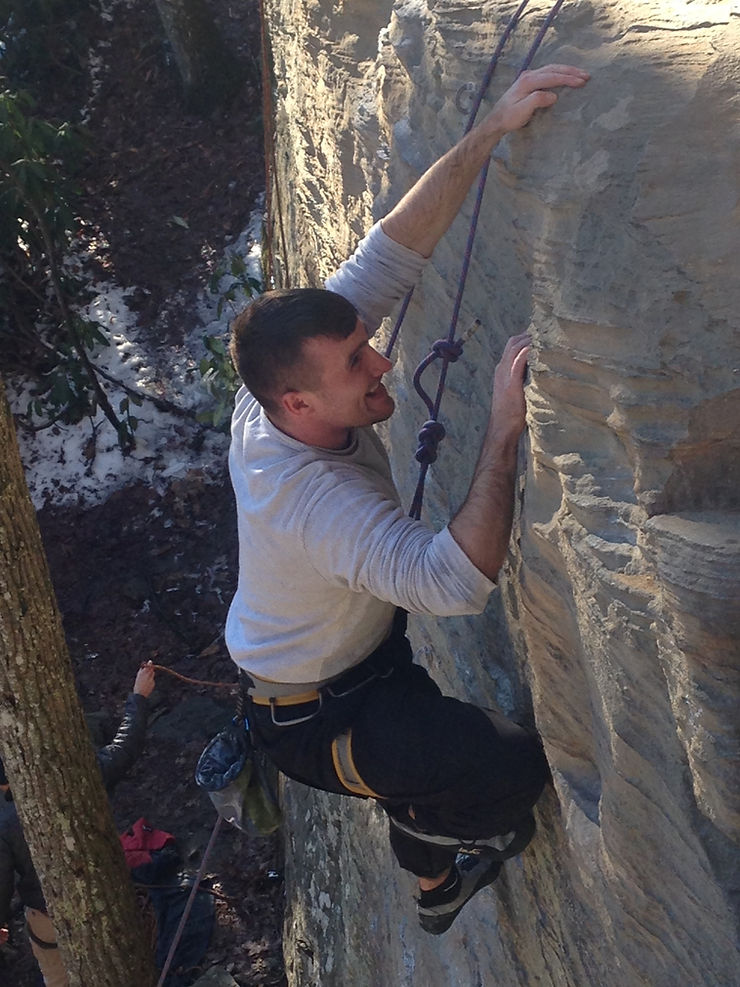
Quite possibly my first day on real rock! Notice the rental harness and shoes, and no helmet!
My personal path to becoming a Rock Guide began back in 2012 when I first visited a climbing gym while stationed in Germany, serving in the Army. I was instantly hooked to climbing as I found it to be the perfect way to de-stress from Army life with a healthy active full body activity. Shortly after by pure luck, the powers that be decided to send me to Ft Knox, Kentucky for my final assignment. I quickly found out I was only 2 hours from the sport climbing mecca that is The Red River Gorge. I fell in love with The Red and climbing and you could find me at the Red every weekend and at the climbing gym at least 3 nights a week. Before I knew it, my Army contract was up and I was honorably discharged in 2014. Literally overnight I found myself living in a VAN DOWN BY THE RIVERRR. (Thank you for that Chris https://youtu.be/Xv2VIEY9-A8 )
That first year out of the Army I drove 68,000 miles criss-crossing the country and climbing all the classic destinations in North America including venturing as far as Canada, Alaska, and Mexico. It was on a rainy day in Alaska, Google searching for a climbing gym, that I stumbled upon The Mountain Training School. This was when I first had the thought that I could make rock climbing into a career. I was first a student and then an apprentice instructor for the Mountain Training School from 2015-2016. I climbed, trained, and instructed all over the world with MTS from Alaska to Patagonia, Spain to Morocco, and even Japan. MTS came to an untimely end at the end of 2016 and I found my first opportunity in the industry right back in The Red River Gorge bringing my journey to a perfect full circle. I participated in my first AMGA course in spring 2016 and completed the process by passing the Rock Guide Exam in spring 2019. I am now on my fourth season guiding for Golden Mountain Guides on the Front Range of Colorado.
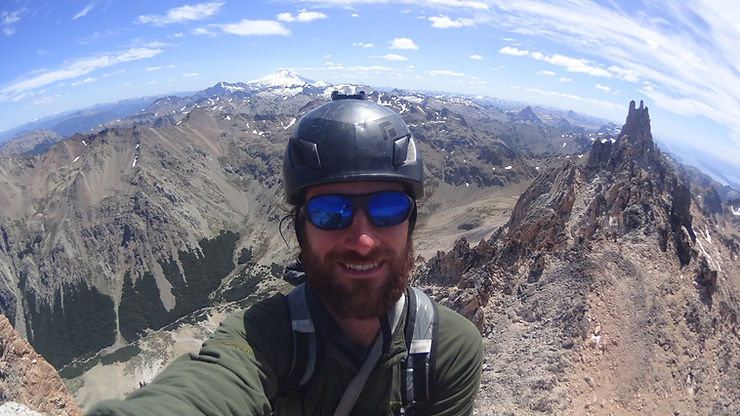
Training to become a Rock Climbing Guide in the alpine playground of The Frey, Argentina
Let’s dive into the nuts and bolts of what it actually looks like to complete that process. To be a certified Rock Guide, candidates must complete the 10 day Rock Guide Course, 10 day Advanced Rock Guide Course and Aspirant Exam, and finally pass the 6 day Rock Guide Exam. That adds up to 26 days total which doesn’t sound like a lot but the candidate must complete specific prerequisites before each course to advance to the next step. It took me three years to complete that process and I estimate that it takes most guides between 2-4 years to complete the whole process depending on individual financial and time constraints.
So how does it all start? To be considered for the Rock Guide Course, one must submit an application with resume satisfying the following requisite skills and experience:
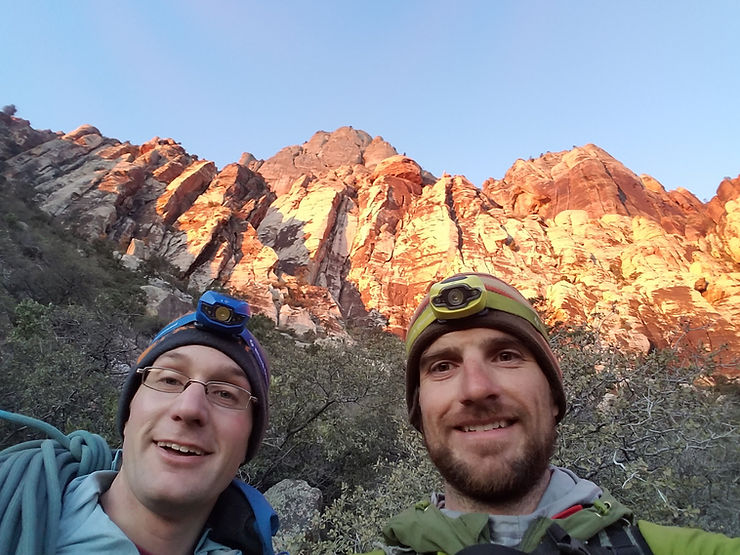
Ben and myself honing our skills in Red Rock, Las Vegas
The application process is competitive and you are not guaranteed a slot in a course; only the top applications are accepted to participate. The RGC includes indoor and outdoor classroom time, practice sessions, and climbing on a variety of rock routes. Recreational climbing skills and judgment are screened as part of the daily activities. The course is designed to introduce some of the recommended methods common to rock guiding through sessions and practical application. After successful completion of the Rock Guide Course, the candidate’s title is Apprentice Rock Guide and is authorized to work under supervision of a Rock Guide, IFMGA Guide, or Tenured Guide on routes up to Grade II. The next step in the process is to complete the following requisites before being eligible to apply for the Advanced Rock Guide Course:
Considering seasons and work schedules, I would estimate that it takes most candidates about a full year to complete the prerequisites necessary to apply for the Advanced Rock Guide Course. Once again the application process is competitive and only the best applications are accepted. The ARGC covers the tools used when guiding and instructing multiple clients on longer routes up to Grade V—management of 3rd and 4th class terrain, technical descents, simultaneous multi-client belaying, lowering and rappelling, management of transitions, and short roping and short pitching techniques. It emphasizes effective risk management while maximizing client rewards. The ARGC has an exam component to the course in which candidates are examined on their movement skills, rescue skills, and actual guiding in the field. To pass the exam component, the candidate must cleanly and easily lead 5.10+ trad, complete a defined rescue scenario covering many improvised rescue skills in a 2:1 ratio in less than 50 minutes, and finally be assessed in the field on terrain up to Grade IV. After successful completion of the Advanced Rock Guide Course and Aspirant Exam, the candidate’s title is Assistant Rock Guide and is authorized to work unsupervised on routes up to Grade IV.
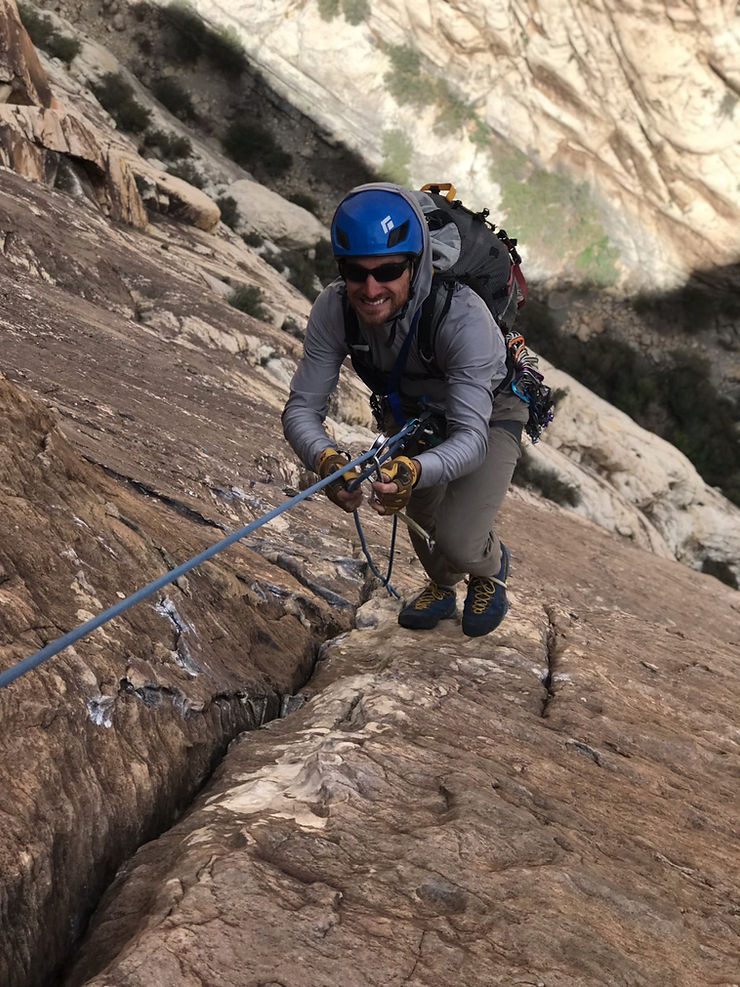
Working hard during my AMGA Rock Guide Exam
Once again the candidate has another set of prerequisites to complete before applying to the Rock Guide Exam:
I estimate most candidates will spend 1-2 years completing the prerequisites and application process for the exam. The goals of the six-day Rock Guide Exam (RGE) are to assess and certify rock-climbing guides at the AMGA and IFMGA international standards and to further the general education of students. During the exam candidates are expected to carry out guiding assignments given by the examiners. Candidates serve as guides to the examiners and to the other participants on routes chosen for their complex guiding challenges. While acting as the guide, candidates are responsible for route planning, client orientation, risk management, and normal guiding practices. Route assignments and client profiles are usually given the night before. Candidates are responsible for obtaining information about the assigned route as well as alternative routes if the original objective proves infeasible. The longer routes (Grade IV and V) undertaken on the RGE require proficiency with multi-client belaying techniques, strong application skills, efficient climbing and protective systems skills and quick and accurate transitions. A strong emphasis is placed on expertise in short roping clients. Candidates are evaluated in the following nine areas: risk management, client care, technical systems, application, terrain assessment, movement skills, mountain sense, professionalism, and instructional technique.
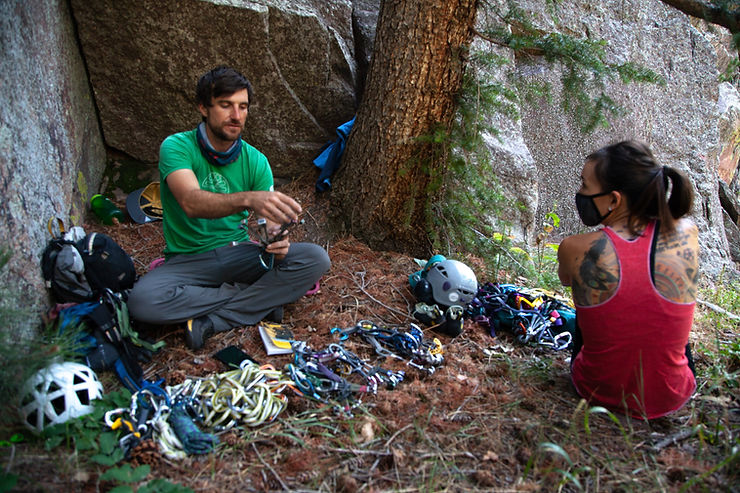
Doing what I love most: helping others build their skills!
And that’s it! That’s all you have to do. Easy peasy, right? Can you smell that sarcasm? The process for me was long and stressful but extremely rewarding. This profession is a labor of love and passion. If you want to become a rock climbing guide, I recommend taking the Single Pitch Instructor Course.
I am grateful for the opportunities I have had in my life and it is with extreme pleasure that I am lucky enough to take you rock climbing as my job. I hope you found this post interesting and insightful. Until next time!



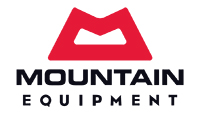
Content Copyright © 2025 of Golden Mountain Guides. All rights reserved. | Privacy Policy | Site Map